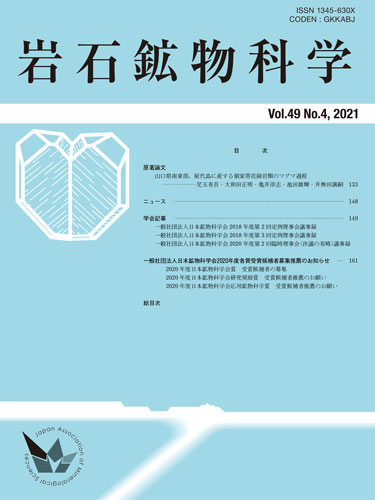
- Issue 4 Pages 49C1-
- Issue 3 Pages 99-
- Issue 2 Pages 51-
- Issue 1 Pages 1-
- |<
- <
- 1
- >
- >|
-
Shogo KODAMA, Masaaki OWADA, Atsushi KAMEI, Yuki IKEDA, Joji IMUTA2021 Volume 49 Issue 4 Pages 133-147
Published: 2021
Released on J-STAGE: March 11, 2021
Advance online publication: February 13, 2021JOURNAL FREE ACCESSThe Cretaceous Ryoke granitoids in Yashiro-jima Island, Yanai district, southeast Yamaguchi Prefecture, are made up of the Gamano granodiorite (Ryoke older granite) and the Towa granodiorite (Ryoke younger granite) with small amounts of the Ryoke metamorphic rocks. The Gamano granodiorite locally shows a foliated structure at the vicinity of metamorphic inclusions. On the other hand, the Towa granodiorite is a relatively massive structure and partly includes K-feldspar phenocrysts. The Gamano granodiorite is accompanied by a lithofacies of biotite granite like that of the Towa granodiorite. In addition, the lithologies having the foliated structure and euhedral K-feldspar phenocrysts that are the lithological characters of the Gamano and Towa granodiorites, respectively, is situated between both granodiorites. These lithofacies gradually change each other. The constituent minerals of both granodiorites are the same, but their modal abundances are different. The Gamano granodiorite involves an accumulation texture of plagioclase under the microscope. The Gamano and the Towa granodiorites geochemically make continuous trends in the Harker diagram, and their Sr-Nd isotopic compositions corrected to 100 Ma are homogeneous. Considering the field occurrence and petrological characteristics, the Towa granodiorite could be essentially formed by the fractional crystallization from the Gamano granodiorite magma with efficiently subtracting plagioclase and biotite. In addition, the accumulation of plagioclase and K-feldspar rarely occurs in the Gamano and Towa granodiorites, respectively. In other words, the Ryoke older and younger granitoids in Yashiro-jima Island were derived from the single parental magma.
View full abstractDownload PDF (4518K)
-
2021 Volume 49 Issue 4 Pages 148
Published: 2021
Released on J-STAGE: March 11, 2021
JOURNAL FREE ACCESS
-
2021 Volume 49 Issue 4 Pages 149-160
Published: 2021
Released on J-STAGE: March 11, 2021
JOURNAL FREE ACCESSDownload PDF (551K)
-
2021 Volume 49 Issue 4 Pages 161-164
Published: 2021
Released on J-STAGE: March 11, 2021
JOURNAL FREE ACCESSDownload PDF (237K)
-
2021 Volume 49 Issue 4 Pages 49C1-49C2
Published: 2021
Released on J-STAGE: March 11, 2021
JOURNAL FREE ACCESS
- |<
- <
- 1
- >
- >|